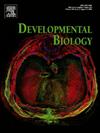Identification of the dysregulated let-7c-Sox2 network in the facial prominences of mouse embryos with early retinoid acid exposure
IF 2.5
3区 生物学
Q2 DEVELOPMENTAL BIOLOGY
引用次数: 0
Abstract
RA signaling is crucial for the anteroposterior pattern formation during neural crest induction and acts as a key environmental cue for cranial neural crest cell migration as well as the subsequent mesenchymal proliferation and differentiation. Congenital malformations including cleft lip and palate have been shown associated with altered embryonic RA signaling both in human and in animal models. In this study, a dysregulated let-7c-Sox2 network was identified in the altered transcriptomic profiles of the facial prominences of E12.5 mouse embryos induced by early RA exposure. Ubiquitously increased expression of let-7c was observed in the epithelium and the mesenchyme of facial prominences of the RA treated mouse and chick embryos. Direct binding and regulation between let-7c and Sox2 was verified using luciferase assay and significant negative correlation between let-7c and Sox2 expression was observed in vitro. Reduced Sox2 expression was predominantly identified in the epithelium of maxillary and palate shelves from E10.5 to E12.5 in RA-induced mouse embryos, resulted in oral adhesion and hypoplasia of palatal shelves that could partly be explained by the reduced mesenchymal proliferation due to upregulation of let-7c, as shown by the results of cell proliferation assay in vitro.

早期类视黄酸暴露小鼠胚胎面部突出部位let-7c-Sox2网络失调的鉴定
RA信号对于神经嵴诱导过程中前后模式的形成至关重要,并且是颅神经嵴细胞迁移以及随后的间质增殖和分化的关键环境线索。包括唇裂和腭裂在内的先天性畸形在人类和动物模型中都被证明与胚胎RA信号的改变有关。在这项研究中,在早期RA暴露诱导的E12.5小鼠胚胎面部突出的转录组谱中发现了失调的let-7c-Sox2网络。在RA处理的小鼠和鸡胚中,let-7c的表达普遍升高。荧光素酶法证实了let-7c与Sox2的直接结合和调控,并在体外观察到let-7c与Sox2的表达呈显著负相关。体外细胞增殖实验结果显示,在ra诱导的小鼠胚胎E10.5 ~ E12.5阶段,上颌和腭架上皮中Sox2的表达明显减少,导致腭架的口腔粘连和发育不全,其部分原因可能是由于let-7c的上调导致间充质细胞增殖减少。
本文章由计算机程序翻译,如有差异,请以英文原文为准。
求助全文
约1分钟内获得全文
求助全文
来源期刊

Developmental biology
生物-发育生物学
CiteScore
5.30
自引率
3.70%
发文量
182
审稿时长
1.5 months
期刊介绍:
Developmental Biology (DB) publishes original research on mechanisms of development, differentiation, and growth in animals and plants at the molecular, cellular, genetic and evolutionary levels. Areas of particular emphasis include transcriptional control mechanisms, embryonic patterning, cell-cell interactions, growth factors and signal transduction, and regulatory hierarchies in developing plants and animals.
 求助内容:
求助内容: 应助结果提醒方式:
应助结果提醒方式:


